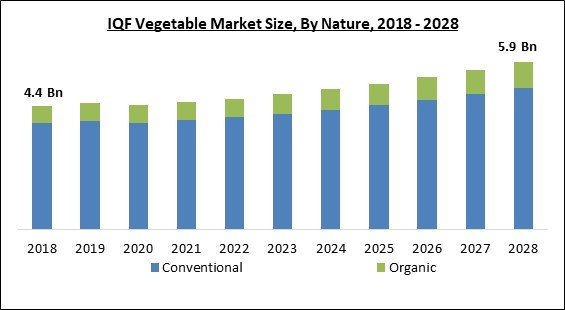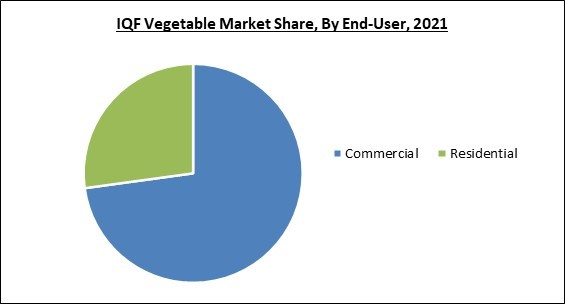The Global IQF Vegetable Market size is expected to reach $5.9 billion by 2028, rising at a market growth of 4.2% CAGR during the forecast period.
IQF is the abbreviation of individually fast frozen. One distinguishing feature of IQF foods is that each serving is frozen in isolation from the rest. A bag of IQF peas, for example, does not contain a single block of frozen peas; instead, every pea is separately frozen and available in a loose condition within the bag, making them far easier to manipulate.
Individual quick freezing a technique used to preserve vegetables for a long period is used to make IQF vegetables, a sort of frozen food product. The vegetable is frozen for 10-12 minutes using the fluidization method in IQF. The vegetables retain their natural flavor, color, and texture. After going through the IQF process, food can be stored at low temperatures, which mitigates some of the issues associated with the traditional approach, where food products deteriorate at low temperatures.
Due to the fast-freezing technique used in IQF, the cell wall of the food is kept intact, preserving the color, texture, and firmness of the vegetable. As a result, the IQF process is thought to be the best way for freezing vegetables when compared to traditional freezing techniques. Vegetables like peas and green beans are typical examples of IQF items.
The IQF method is used to treat whole birds, including frozen turkeys. The IQF method, also known as flash-freezing, involves putting the individual food products on a sort of conveyor into a blast chiller, which swiftly freezes them. The food pieces stay separate after freezing because they are separate when they are put in.
The market research report covers the analysis of key stakeholders of the market. Key companies profiled in the report include Alfred Zindel AG, Brecon Foods, Inc., B&G Foods, Inc., Capricorn Food Product India Ltd., Greenyard NV, Meyer Gemüsebearbeitung GmbH, REMS Frozen Foods, Simplot Australia Pty. Ltd., Staple Food Group (Staple Dairy Products Ltd.) and Uren Food Group Limited.
IQF is the abbreviation of individually fast frozen. One distinguishing feature of IQF foods is that each serving is frozen in isolation from the rest. A bag of IQF peas, for example, does not contain a single block of frozen peas; instead, every pea is separately frozen and available in a loose condition within the bag, making them far easier to manipulate.
Individual quick freezing a technique used to preserve vegetables for a long period is used to make IQF vegetables, a sort of frozen food product. The vegetable is frozen for 10-12 minutes using the fluidization method in IQF. The vegetables retain their natural flavor, color, and texture. After going through the IQF process, food can be stored at low temperatures, which mitigates some of the issues associated with the traditional approach, where food products deteriorate at low temperatures.
Due to the fast-freezing technique used in IQF, the cell wall of the food is kept intact, preserving the color, texture, and firmness of the vegetable. As a result, the IQF process is thought to be the best way for freezing vegetables when compared to traditional freezing techniques. Vegetables like peas and green beans are typical examples of IQF items.
The IQF method is used to treat whole birds, including frozen turkeys. The IQF method, also known as flash-freezing, involves putting the individual food products on a sort of conveyor into a blast chiller, which swiftly freezes them. The food pieces stay separate after freezing because they are separate when they are put in.
COVID-19 Impact Analysis
The COVID-19 pandemic has had a negative effect on the market. The sale of IQF vegetables has been severely affected by recent announcements on the closure of a sizable chunk of the food service sector, particularly full-service restaurants and quick-service restaurants. Worldwide logistics & transportation have been considerably impacted by the trade restrictions put in place by a number of nations to stop the spread of COVID-19, which has had an impact on the IQF vegetable market. The closure of food service industry participants including quick-service restaurants and full-service restaurants had an impact on the sales of IQF vegetables.Market Growth Factors
Fast food restaurants are gaining popularity
Every community and culture in the world depend heavily on the food. Before the 20th century, the majority of people preferred to consume freshly prepared meals. It required meticulous planning to prepare for eating. However, it could be observed that the majority of people enjoy eating fast food, which is bad for their physical and mental health, such as hamburgers, pizza, and fried chicken.The longer shelf life of IQF vegetables is anticipated to boost market expansion.
The creation, processing, and storage of IQF food are all done using technology, which has led to an increase in demand. IQF technology has improved the ability to safely preserve fruits and vegetables for long periods of time while stored at specific temperatures. In contrast to cold storage methods, which control moisture, the IQF process uses nitrogen to freeze each individual vegetable unit. Depending on the source, IQF veggies have a shelf life of several weeks to months, making it possible to store them without worrying about them going bad.Market Restraining Factors
The frostability of IQF vegetable's surface is high
The icing issue is the single most frustrating aspect of utilizing a quick freezer. There should be a large number of establishments interested in getting a quick freezer so that they can freeze their fresh fish, meat, and vegetables. Meat, fish, vegetables, and other things high in moisture can be frozen successfully in a standard quick-freezer, but the food will dry out as the moisture evaporates throughout the freezing process. Frosting forms on frozen foods when airborne water vapor condenses on their surfaces after dehydration occurs during the freezing process.Nature Outlook
Based on nature, the IQF vegetable market is segmented into conventional and organic. In 2021, the conventional segment dominated the IQF vegetable market with the maximum revenue share. This is explained by the fact that quick-service restaurants and fast-food chains have adopted IOF vegetables as a fresh vegetable substitute since they need less preparation time and result in shorter customer wait times. This serves as a major catalyst for the commercial segment.End-User Outlook
On the basis of end user, the IQF vegetable market is fragmented into commercial and residential. In 2021, the residential segment covered a significant revenue share in the IQF vegetable market. The market is expanding in this segment due to the rising number of working women who have lesser time to prepare food. Moreover, the demand for IQF vegetables would grow in the upcoming years due to the nutritional value offered by the IQF vegetables.Distribution Channel Outlook
By distribution channel, the IQF vegetable market is divided into online stores, supermarket/ hypermarket, business to business (B2B) and others. The B2B segment witnessed the highest revenue share in the IQF vegetable market in 2021. The increase in demand for IQF vegetables in the food service sector is to blame for this. It is a result of the most important aspects influencing corporate organizations' purchases of freeze-dried foods, such as cost, a longer shelf life, compatibility, the ease with which seasonal fruits and vegetables can be stocked, and seasonality. Food processing industries like confectioneries, bakeries, and dairy are using a variety of IQF vegetables.Regional Outlook
Region wise, the IQF vegetable market is analyzed across North America, Europe, Asia Pacific and LAMEA. In 2021, the North America region led the IQF vegetable market by generating the largest revenue share. This is due to the increased consumption of frozen veggies and canned tomatoes in this region compared to other forms like fresh ones or purees/pastes/pureed dishes created using only canned tomatoes. Also, in the region demand is increasing due to the growing preference of healthy diet.The market research report covers the analysis of key stakeholders of the market. Key companies profiled in the report include Alfred Zindel AG, Brecon Foods, Inc., B&G Foods, Inc., Capricorn Food Product India Ltd., Greenyard NV, Meyer Gemüsebearbeitung GmbH, REMS Frozen Foods, Simplot Australia Pty. Ltd., Staple Food Group (Staple Dairy Products Ltd.) and Uren Food Group Limited.
Scope of the Study
By Nature
- Conventional
- Organic
By End-user
- Commercial
- Residential
By Distribution Channel
- Business to Business (B2B)
- Online Stores
- Supermarket/Hypermarkets
- Others
By Geography
- North America
- US
- Canada
- Mexico
- Rest of North America
- Europe
- Germany
- UK
- France
- Russia
- Spain
- Italy
- Rest of Europe
- Asia Pacific
- China
- Japan
- India
- South Korea
- Singapore
- Malaysia
- Rest of Asia Pacific
- LAMEA
- Brazil
- Argentina
- UAE
- Saudi Arabia
- South Africa
- Nigeria
- Rest of LAMEA
Key Market Players
List of Companies Profiled in the Report:
- Alfred Zindel AG
- Brecon Foods, Inc.
- B&G Foods, Inc.
- Capricorn Food Product India Ltd.
- Greenyard NV
- Meyer Gemüsebearbeitung GmbH
- REMS Frozen Foods
- Simplot Australia Pty. Ltd.
- Staple Food Group (Staple Dairy Products Ltd.)
- Uren Food Group Limited
Unique Offerings
- Exhaustive coverage
- The highest number of Market tables and figures
- Subscription-based model available
- Guaranteed best price
- Assured post sales research support with 10% customization free
Table of Contents
Chapter 1. Market Scope & Methodology
Chapter 2. Market Overview
Chapter 3. Global IQF Vegetable Market by Nature
Chapter 4. Global IQF Vegetable Market by End-User
Chapter 5. Global IQF Vegetable Market by Distribution Channel
Chapter 6. Global IQF Vegetable Market by Region
Chapter 7. Company Profiles
Companies Mentioned
- Alfred Zindel AG
- Brecon Foods, Inc.
- B&G Foods, Inc.
- Capricorn Food Product India Ltd.
- Greenyard NV
- Meyer Gemüsebearbeitung GmbH
- REMS Frozen Foods
- Simplot Australia Pty. Ltd.
- Staple Food Group (Staple Dairy Products Ltd.)
- Uren Food Group Limited
Methodology

LOADING...
Table Information
| Report Attribute | Details |
|---|---|
| No. of Pages | 171 |
| Published | October 2022 |
| Forecast Period | 2021 - 2028 |
| Estimated Market Value ( USD | $ 4490 Million |
| Forecasted Market Value ( USD | $ 5925 Million |
| Compound Annual Growth Rate | 4.2% |
| Regions Covered | Global |
| No. of Companies Mentioned | 10 |










